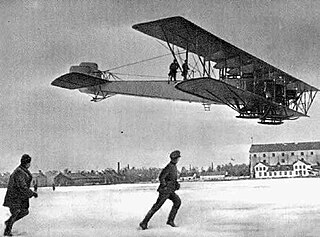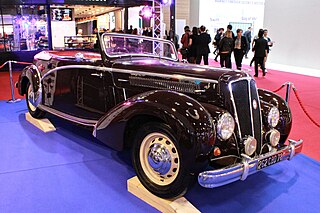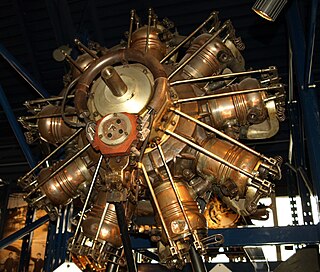
The Sikorsky Ilya Muromets were a class of Russian pre-World War I large four-engine commercial airliners and military heavy bombers used during World War I by the Russian Empire. The aircraft series was named after Ilya Muromets, a hero from Slavic mythology. The series was based on the Russky Vityaz or Le Grand, the world's first four-engined aircraft, designed by Igor Sikorsky. The Ilya Muromets aircraft as it appeared in 1913 was a revolutionary design, intended for commercial service with its spacious fuselage incorporating a passenger saloon and washroom on board. During World War I, it became the first four-engine bomber to equip a dedicated strategic bombing unit. This heavy bomber was unrivaled in the early stages of the war, as the Central Powers had no aircraft capable enough to rival it until much later.

British Salmson was a British based manufacturer of cars, from 1934 to 1939. An offshoot of the French Salmson company, it was taken over by local management. After producing war supplies during World War II, it ceased car production, moved to Glasgow, Scotland, and produced printing machinery.

The Jodel D.11 is a French two-seat monoplane designed and developed by Société Avions Jodel in response to a French government request for a low-wing aircraft for use by the nation's many emerging flying clubs.

Between 1920 and 1951 the Société des Moteurs Salmson in France developed and built a series of widely used air-cooled aircraft engines.

The Wight Pusher Seaplane, or Navyplane, was a British twin-float patrol seaplane produced by John Samuel White & Company Limited.

The Salmson Phrygane ("Caddisfly") was a French light aircraft of the 1930s.

The Kennedy Giant was a British biplane heavy bomber designed by Kennedy Aeroplanes Ltd. during the First World War. The design was an imitation of works by Igor Sikorsky, with whom the owner of Kennedy Aeroplanes Ltd., C. J. H. Mackenzie-Kennedy, had ostensibly worked prior to setting up the company. The aeroplane was a notorious failure; its size meant that construction had to take place in an open field as none of the hangars near Hayes, Middlesex, where the prototype was assembled, were large enough to house it. For its weight, the aircraft's four engines were inadequate, and the resulting under-powered aircraft could only fly in a straight line once airborne.

Salmson is a French engineering company. Initially a pump manufacturer, it turned to automobile and aeroplane manufacturing in the 20th century, returning to pump manufacturing in the 1960s, and re-expanded to a number of products and services in the late 20th and into the 21st century. It is headquartered in Chatou and has production facilities in Laval. It has subsidiaries in Argentina, Italy, Lebanon, Portugal, South Africa and Vietnam.

The Indraéro Aéro 101 was a light training biplane developed in France in the 1950s.

The Caudron C.230 was a sporting, touring and trainer aircraft produced in France in 1930. It was a conventional biplane with single-bay, unstaggered wings of equal span. The pilot and a single passenger sat in tandem open cockpits. It featured a wooden fuselage with plywood skin.

The Sopwith Bat Boats were British flying boats designed and built from 1912 to 1914. A single-engined pusher biplane, the Bat Boat was the first successful flying boat and amphibious aircraft built in the United Kingdom, with examples used by the Royal Navy and by Greece and Germany.

The Salmson 9 AD was a family of air-cooled nine cylinder radial aero-engines produced in the 1930s in France by the Société des Moteurs Salmson.

The Salmson B.9 was a French designed, nine-cylinder, water-cooled radial aero engine that was produced under license in Britain. The engine was produced between August 1914 and December 1918. The French version was designated 9B with a slightly increased capacity variant known as the R.9 or 9R. A further variant known as the M.9 or 9M unusually drove the propeller through a 90-degree gear train.

The Salmson AD.3 or Salmson 3 Ad was a French designed, three-cylinder, air-cooled radial aero engine. It was also produced by British Salmson in Great Britain during the 1920s.

British Salmson aero-engines refers to a series of small French designed, air-cooled radial aero engine that were produced by British Salmson, under license from Société des Moteurs Salmson, in Great Britain during the late 1920s and 1930s.

The Starck AS-70 Jac is a French-built single-seat light aircraft of the mid-1940s.
The Indraéro Aéro 30 is a single seat, single engined sports biplane designed in France in the late 1960s. Only one was built.

The Salmson water-cooled aero-engines, produced in France by Société des Moteurs Salmson from 1908 until 1920, were a series of pioneering aero-engines: unusually combining water-cooling with the radial arrangement of their cylinders.

The Organization of the Air Service of the American Expeditionary Force on November 11, 1918 represents its maximum strength in World War I. Units of the Air Service are listed as assigned to the order of battle for that date, which was that of the Armistice with Germany. The first air unit arrived in France in September 1917, while the final air unit reaching the front did so on November 9, 1918. Unit operations began in April 1918. At the armistice, 57,508 officers and men served in the Air Service of the AEF, 24,512 in the Zone of Advance, and 32,996 in the Services of Supply. Of its 6,861 officers, 4,088 were on flying status and 219 were qualified observation balloon aviators. 1,724 of those on flying status and approximately 100 of the balloonists served in combat units.




















